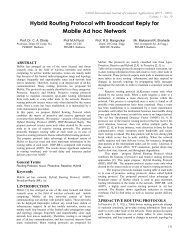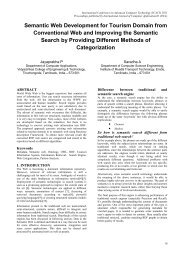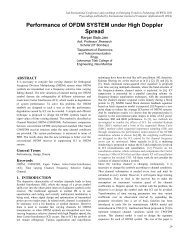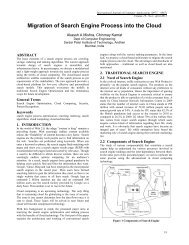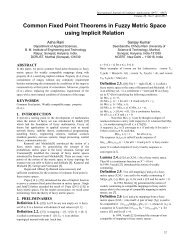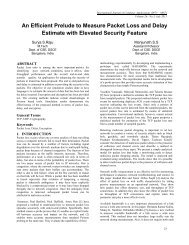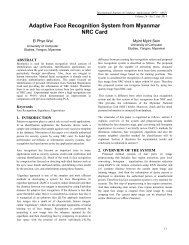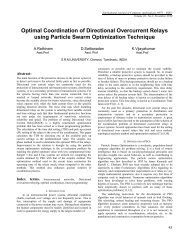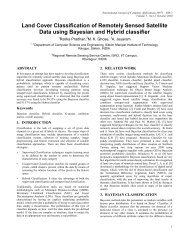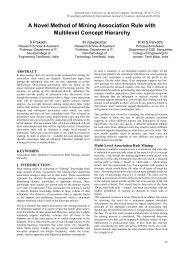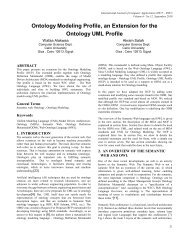IJCA Template - International Journal of Computer Applications - IJCA
IJCA Template - International Journal of Computer Applications - IJCA
IJCA Template - International Journal of Computer Applications - IJCA
You also want an ePaper? Increase the reach of your titles
YUMPU automatically turns print PDFs into web optimized ePapers that Google loves.
BER<br />
FER<br />
BER<br />
<strong>International</strong> <strong>Journal</strong> <strong>of</strong> <strong>Computer</strong> <strong>Applications</strong> (0975 – 8887)<br />
Volume 7– No.7, October 2010<br />
channel. It is worth mentioning that the number <strong>of</strong> iterations<br />
needed for Rayleigh fading channel is about the same as for the<br />
AWGN channel.<br />
10 -1<br />
10 0 SNR (dB)<br />
10 -2<br />
10 0<br />
10 -1<br />
10 -3<br />
10 -5 (1057,813)-15iter<br />
0 1 2 3 4 5 6 7 8 9 10<br />
SNR (dB)<br />
4.2 Normal Gauss or Body Text<br />
Rayleigh<br />
Please use a 9-point Times Roman font, or other Roman font with<br />
10<br />
serifs, -2<br />
as close as possible in appearance to Times Roman in<br />
which these guidelines have been set. The goal is to have a 9-<br />
point text, as you see here. Please use sans-serif or nonproportional<br />
fonts only for special purposes, such as<br />
distinguishing source code text. If Times Roman is not available,<br />
try the 10 -4<br />
font named <strong>Computer</strong> Modern Roman. On a Macintosh,<br />
(73,45)-5iter<br />
use the font (273,191)-8iter named Times. Right margins should be justified, not<br />
(819,447)-15iter<br />
ragged.<br />
Fig. 4: FER performance <strong>of</strong> (73,45), (273, 191), (819, 447) and<br />
(1057,813) codes on AWGN and Rayleigh fading channels<br />
OSMLD codes are LDPC(Low Density Parity Check) codes and<br />
can be decoded by belief propagation (BP) algorithm [11]. BER<br />
Performance <strong>of</strong> iterative decoding for (73,45) and (273,191)<br />
codes are shown and compared to those <strong>of</strong> BP[11] in Figure 5. As<br />
it can be seen our results are worse by 0.2 dB at BER 10 -5 . This<br />
coding gain is negligible compared to the required complexity<br />
(see Table 3).<br />
Table 3 shows simulation time to decode 1000 frame <strong>of</strong> (73, 45),<br />
(273,191), (819,447) and (1057, 813) codes with our algorithm<br />
and BP algorithm using 15 iterations (by using a computer with<br />
Pentium 4, 3.06 GHz ). We can observe that as the code length<br />
increases the computational time complexity <strong>of</strong> BP increases<br />
compared to that <strong>of</strong> our iterative decoding algorithm.<br />
4.3 Performances <strong>of</strong> product codes<br />
This section considers simulation results and analysis for some PC<br />
and PCB codes, all <strong>of</strong> which use one step majority logic<br />
decodable (OSMLD) component codes (see Table 2).<br />
In Fig.6, we present the simulation results for the (4545, 2025)<br />
PCB code <strong>of</strong> rate 0.45 constructed from (73, 45) DSC code. We<br />
can see that the improvement is great for the first iterations and is<br />
negligible after the 16 th iteration. Here we recognize the Turbo<br />
effect.<br />
In Fig.7, we present a comparison between our simulation results<br />
and results published in [3] for the (4545, 2025) PCB code.<br />
Although they use a modified Gaussian channel with a tanh<br />
function modulation, their results are worse by 0.6 dB at a BER <strong>of</strong><br />
10 -4 .<br />
The Fig. 8 shows that performance results after 50 iterations for<br />
the (17633,8595) PCB code is only 1.8 dB away from the<br />
Shannon capacity limit at a BER <strong>of</strong> 10 -5 .<br />
In Fig.9, we present the simulation results for the (1533,495)<br />
asymmetric PC code <strong>of</strong> rate 0.32 constructed from (21, 11) and<br />
(73, 45) DSC code. As can be seen, performance increases with<br />
each iteration.<br />
10 -3<br />
10 -4<br />
10 -5<br />
10 -6<br />
10 -7<br />
(73,45)-5iter<br />
(73,45)-BP,50iter<br />
(273,191)-8iter<br />
(273,191)-BP,50iter<br />
0 0.5 1 1.5 2 2.5 3 3.5 4 4.5 5<br />
Fig. 5: Performance <strong>of</strong> (73,45) and (273,191) in comparison<br />
with BP on AWGN channel<br />
Table 3 : Comparison in terms <strong>of</strong> time computation and error<br />
performances<br />
Codes Our<br />
algorithm<br />
BP<br />
algorithm<br />
Gain <strong>of</strong> BP<br />
at BER=10 -5<br />
(73,45) 4[s] 23[s] 0.2 dB<br />
(273,191) 58[s] 300[s] 0.2 dB<br />
(1057,813) 801[s] 13000[s] 0.45 dB<br />
10 0<br />
10 -1<br />
10 -2<br />
10 -3<br />
10 -4<br />
iteration (1)<br />
iteration (2)<br />
10 -5 iteration (4)<br />
iteration (8)<br />
iteration (16)<br />
10 -6 iteration (20)<br />
1 1.5 2 2.5<br />
SNR (dB)<br />
Fig. 6 Performance <strong>of</strong> iterative decoding <strong>of</strong> the (4545,2025)<br />
code on AWGN channel<br />
The curves in Fig.10 present the simulation results for the<br />
(1253,495), (4545,2025) PCB codes and (5329,2025) PC. The<br />
PC is compared to two PCB codes. In the first case, the PC is<br />
compared to the PCB code constructed from the same component<br />
codes ((73, 45) DSC code). As envisaged, the PC outperforms the<br />
PCB code. In the second case, the PC is compared to a PCB code<br />
with same rate. As can be seen, the PC is better than PCB code. It<br />
seems that contrary to the PCB codes, product codes doesn’t have<br />
error floor. Furthermore, product codes are better than PCB codes<br />
for larger SNR.<br />
16



